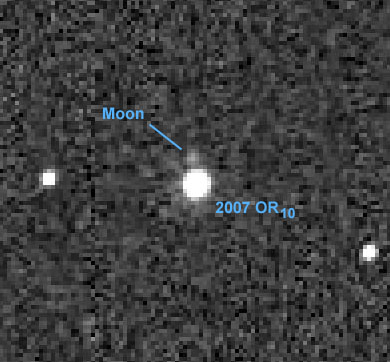Astronomy - Big Kuiper Object 2007 OR10 Has a Moon
Hubble images reveal a satellite orbiting one of the Kuiper Belt's biggest objects.
An interesting trend has emerged concerning the largest objects in the distant Kuiper Belt: they have moons. Most notable is Pluto, with five. Haumea has two. Eris, Orcus, Quaoar, and Makemake each have one. In fact, of the eight largest known trans-Neptunian objects, only Sedna and yet-to-be-named 2007 OR10 were considered moonless — and now it's just Sedna.

Little is known about the moon of Kuiper Belt object 2007 OR10, seen here in a Hubble Space Telescope image taken September 18, 2010.
NASA / ESA / W. Fraser / G. Marton
NASA / ESA / W. Fraser / G. Marton
Astronomers Gábor Marton and Csaba Kiss (Konkoly Observatory, Hungary), and Thomas Müller (Max Planck Institute, Germany) have identified a moon orbiting 2007 OR10. They spotted it in Hubble Space Telescope images taken in September 2010 as part of a survey of trans-Neptunian objects. Marton announced the discovery this week at a joint meeting of the AAS's Division for Planetary Sciences and the European Planetay Science Congress.
Although 2007 OR10 itself has been known for almost a decade, only recently have researchers realized that it's surface is quite dark and therefore that it must be quite sizable, with an estimated diameter of 1,535 km (955 miles). This makes it the third-largest dwarf planet, after Pluto and Eris. It also ranks third for distance — 13 billion km or 87 astronomical units away — drifting among the stars of central Aquarius at a dim magnitude 21.
For now, not much is known about its companion. Aside from HST's 2010 survey, the discoverers report a tentative detection of the moon in images from 2009. It orbits at a distance of at least 15,000 km, but more specifics are lacking. However, Marton's team has requested more HST time for follow-up observations. As soon as a reliable orbital radius and period are found, quick calculations will yield the mass of 2007 OR10 and its overall density.
Meanwhile, the orbit of 2007 OR10 itself is now known well enough that the Minor Planet Center has assigned this body the number 225088. This means it can be officially named, but discoverers Megan Schwamb, Michael Brown, and David Rabinowitz have yet to submit one. For a while it had the nickname “Snow White,” because the discovery team believed it to be much smaller and more reflective.
Infrared spectra show that the surface, despite being dark, must be quite red (perhaps stained by organic compounds) and generously coated with water ice.
No comments:
Post a Comment